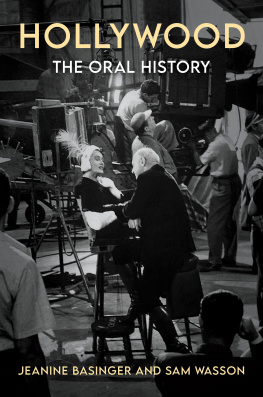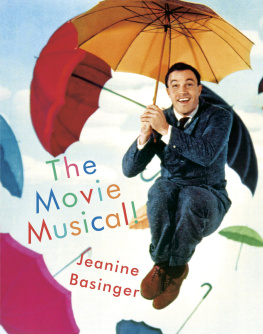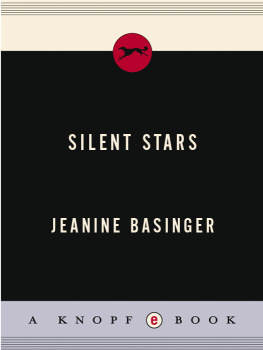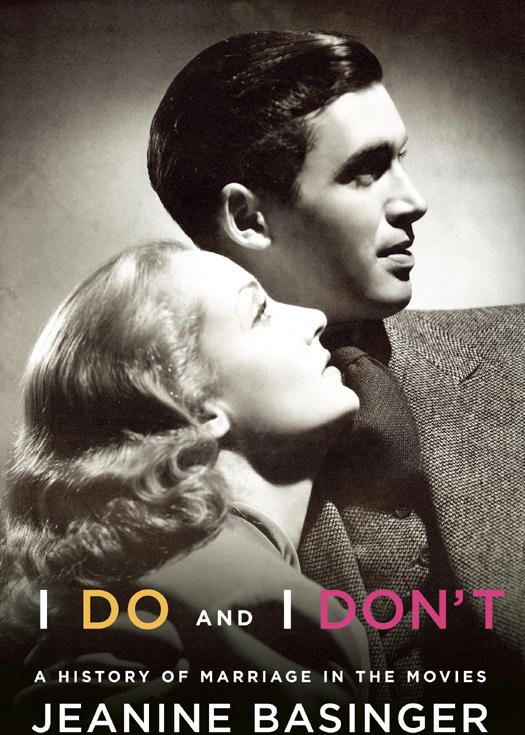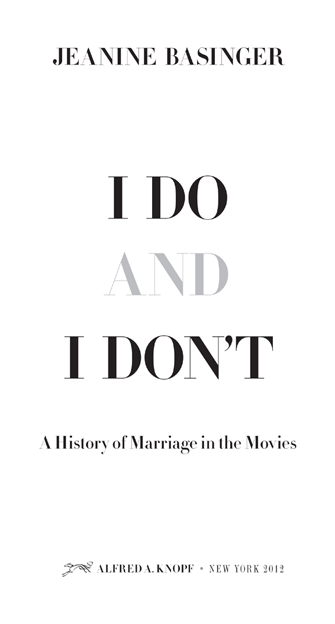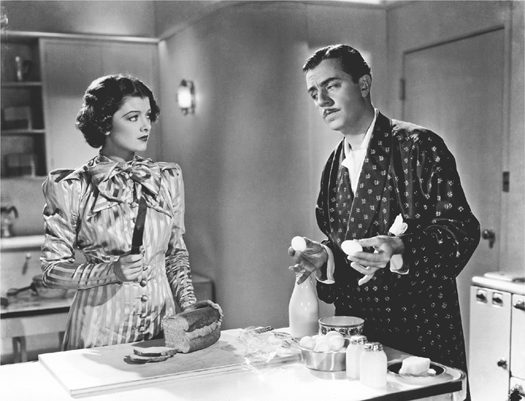
(Photo Credit )
This Is a Borzoi Book
Published by Alfred A. Knopf
Copyright 2012 by Jeanine Basinger
All rights reserved. Published in the United States by Alfred A. Knopf, a division of Random House, Inc., New York, and in Canada by Random House of Canada Limited, Toronto.
www.aaknopf.com
Knopf, Borzoi Books, and the colophon are registered trademarks of Random House, Inc.
Library of Congress Cataloging-in-Publication Data
Basinger, Jeanine.
I do and I dont : a history of marriage in the movies /
Jeanine Basinger.First edition.
pages cm
Includes bibliographical references and index.
eBook ISBN: 978-0-307-96222-5
Hardcover ISBN: 978-0-307-26916-4
1. Marriage in motion pictures. 2. Marriage in popular culture
United States. I. Title.
PN 1995.9. M 3 B 37 2012
791.43655dc23 2012036283
Front-of-Cover photograph: Carole Lombard and James Stewart in Made for Each Other.
Cover design by Carol Devine Carson
Frontispiece: Myrna Loy and William Powell in After the Thin Man, married but not domestic
v3.1
This book is dedicated to the man I married
at a Justice of the Peace office in Saratoga Springs
on September 22, 1967.
O the wo that is in marriage!
The Wife of Bath
CONTENTS
PART ONE:
THE SILENT ERA
PART TWO:
DEFINING THE MARRIAGE MOVIE
IN THE STUDIO SYSTEM
PART THREE:
THE MODERN ERA
ACKNOWLEDGMENTS
I have always been fortunate in having superb family, friends, colleagues, and students who have supported my efforts in everything Ive attempted. There are many to thank. At Wesleyan University, I have the best fellow film faculty anyone could want, superb sounding boards one and all: Steve Collins, Lisa Dombrowski, Scott Higgins, Leo Lensing, Marc Longenecker, Katya Straub, Jacob Bricca, Krishna Winston, and Wesleyans President, Michael Roth. Everyone who works around me, Joyce Heidorn, Sal Privatera, Joan Miller, and most especially and most exceptionally, Lea Carlson, deserve thanks. The list of former students who contribute ideas to my work would be endless, but for this book Ill single out Jeffrey Lane, Sammy Wasson, Eric Lichtenfeld, Joss Whedon, Paul Weitz, Miguel Arteta, Eric Levy, David Kendall, Ed Decter, Domenica Cameron-Scorsese Frenzel, Owen Renfroe, and especially Jeremy Arnold, who also did amazing photo research. I always find great conversations about anything to do with movies from old friends such as Leonard, Alice, and Jessie Maltin; Richard Schickel, Annie Schulhoff, and Richard Slotkin. For this particular book, both Molly Haskell and David Thomson gave me great advice on the pitfalls of attempting to write about marriage, and Clint Eastwood provided thoughtful insight into unusual married relationships in our conversations about his film J. Edgar. I thank Ron and Howard Mandelbaum and Buddy Weiss of Photofest, and Maxine Fleckner Ducey at the Wisconsin Center for Film and Theater Research for their research efforts, deep knowledge of film history, and intrepid location of stills, and Robert Osborne of TCM provided both insight and access to Seventh Sin. Many thanks go to all the people at Knopf who contributed to this book: the talented and sensitive designer, Iris Weinstein; the scrupulous and patient production editor, Kevin Bourke; the brilliant jacket designer, Carol Carson; the indefatigable Romo Enriquez; and eager editorial assistant Dan Schwartz.
As ever, I thank (and thank again) my editor, the fabulous Bob Gottlieb, who has never been anything but patient with me (and my lack of a computer), and who always asks the key question at the key moment. His ability to find exactly the right film (Flavor of Green Tea Over Rice) or the right television show (Friday Night Lights, Borgen) to make the right point is simply amazing. And hes funny, too.
For my family goes an extra truckload of thanks, since this project took much support from everyone: my husand, John; my daughter, Savannah; my granddaughter, Kulani; and my son-in-law, Rob (who had to help with computers). From one and all I received good ideas, encouragement, and the reassurance that I do! can still be a viable form of the marriage story.
AUTHORS NOTE
T his is a book about marriage in the movies, and yes, I am married. I have been for forty-five years, and to the same saint of a guy. When we first announced wed wed, his friends gave it five minutes, and mine about ten. Yet here we are, forty-five years later, long after most of them have hit the divorce courts at least once. (Somebody once told me, You two are like one of those movie marriages where hes a cowboy and shes a fashion designer and the whole audience knows its never gonna work, but the movie claims it will.)
In writing this book, I am doing something unfashionable. I am describing stars and stories and business strategies, and I am not analyzing sociological and cultural influences, discussing psychoanalytical theory or the differences between the male and the female gaze. These things are all worthwhile pursuits, but this book is an overview of how commercial movies told the story of marriage, and how they used it to draw audiences into the theater. The book is descriptive, historical, and personally speculative. Its about what the average person saw and heard at the movie theater. Nothing more and nothing less. Its written in plain language, and it just tries to describe what was there up on the screen over a few decades of American life. It is not heavily footnoted (except with personal asides), but it is carefully researched. In presenting it, I am well aware that scholars wont think its scholarly enough, and general readers will think its too scholarly. Its a book for people who like movies and want to share a conversation about them.
This book does not represent how I teach my film classes: its a book about content rather than a formalist examination of movie aesthetics. I chose to do this because in watching marriage movies, I felt that they were pitched at the audiences own level of experience more closely than any other type of movie I had seen. These movies were about content. They were talking to an audience who knew the subject, knew the subtext, knew the reality. I think this is one of the reasons that the topic of marriage in the movies, unlike the American West, horror, melodrama, combat, crime, and others, has not yet captured the full attention of academia. There are books on romantic comedy, and books on runaway brides, and Stanley Cavells well-respected book on comedies of remarriage, but very little on marriage itself.
Cavells book uses a series of celebrated screwball comedies from the 1930s and early 1940s to discuss the well-known characteristics of the genre but also to use the films to ask philosophical questions: What is a marriage? Is marriage merely habit? If the habits arent working, should the marriage be broken up? And what are the habits that American popular culture encourages audiences to pursue? Cavell discusses the transformative process of marriage between a man and a woman, and he uses recognizable film-studies issues such as the way movies begat movies, how they always refer to each other (concepts of film genre study), and how movie stars become real to viewers as a persona they carry from film to film. Cavell translates philosophical issues onto popular Hollywood comedies. He understands that people who went to the movies experienced them as a conversation carried from film to film, a conversation that influenced the way American filmgoers thought, felt, and responded to life. Cavells thoughts are beautifully expressed, and his appreciation of the films he writes about is deep and joyous. My book differs in one simple way: he uses movies to think about philosophy; I use them to think about movies.


